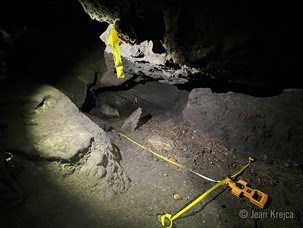Part of a series of articles titled The Midden - Great Basin National Park: Vol. 22, No. 2, Winter 2022.
Article
Mark and Recapture Study for the Model Cave Harvestman, Sclerobunus ungulatus
This article was originally published in The Midden – Great Basin National Park: Vol. 22, No. 2, Winter 2022.

Jean Krejca
By Shiloh McCollum, Biologist, Great Basin Institute
Arachnids, particularly shy cavernicolous ones, keep their secrets close to their scute. In fact, they don’t like to spill the beans at all. In order to engage them in disclosing all their secrets we cannot whisper sweet nothings, instead hard science is called to the field of battle.Harvestmen are solitary, photophobic omnivores that can sometimes exceed, in biomass, the number of spiders1. Cavernicolous species often have less seasonal variation than surface species1, but overall, not a lot is known about them. Sometimes they have continuous reproduction, sometimes not. Sometimes they guard their eggs and juveniles, sometimes not. Sometimes they are highly vagile (like to move), sometimes not.1
Sclerobunus ungulatus, the Model Cave Harvestman, is endemic to Great Basin Caves and even less is known of their secrets. We do not know if they feed on feces or springtails1. We do not know much about their biology, population dynamics, vagility, or really any of their secrets. We do know that the type specimen was collected in 1952 from Model Cave2. It differs from the closely related Sclerobunus cavicolens by a variety of features, including a lack of pigmentation2. It also differs from Sclerobunus madhousensis by a longer second leg and a limited range (S. madhousensis is endemic to caves near Provo, UT)2. Its current range covers the Baker Creek Watershed and 2 high elevation caves3,4. Thus, we are introducing a mark and recapture study in order to gain more knowledge and plunder secrets like mad pirates… or mad scientists (really, a very fine line sometimes).

Jean Krejca
The study is conducted every month by the same two researchers to reduce variables. Each researcher searches a transect for 15 minutes, collects all the specimens of interest they find, and makes observations of other species nearby (possible prey items). Then the other researcher does the same for another 15-minute pass. Once captured, the specimens are marked with fluorescent, acrylic paint with unique identifiers. A different color is used for each capture date, and a different leg is painted based on the transect.

Shiloh McCollum
After a year of our study, data will be compiled and crunched using appropriate statistical methods1 to learn as much as we can about population size, size classes, life span, reproduction, and any other biological observations we can glean during our study. Using Model Cave, we can then begin to unravel S. ungulatus’ secrets.
Citations
- Augusto Macedo Mestre L, Pinto-da-Rocha R(2004) Population Dynamics of an Isolated Population of the Harvestmen Ilhaia cuspidata (Opiliones, Gonyleptidae) in Araucaria Forest (Curitiba, Parana, Brazil). The Journal of Arachnology 32:208-220
- Derkarabetian S, Hedin M (2014) Integrative Taxonomy and Secies Delimination in Harvestmen: A revision of the Western North American Genus Sclerobunus (Opiliones: Laniatores: Travunioidea). PLoS ONE 9(8): e104982
- Krejca JK, Taylor SJ (2003) A Biological Inventory of Eight Caves in Great Basin National Park. White Paper. Park Files.
- Taylor SJ, Krejca JK, Slay ME (2008) Cave biota of Great Basin National Park, White Pine County, Nevada. Illinois National Historical Survey, Champaign, Illinois. Center for Biodiversity Technical Report 25: 398 pgs.
Last updated: February 6, 2024
